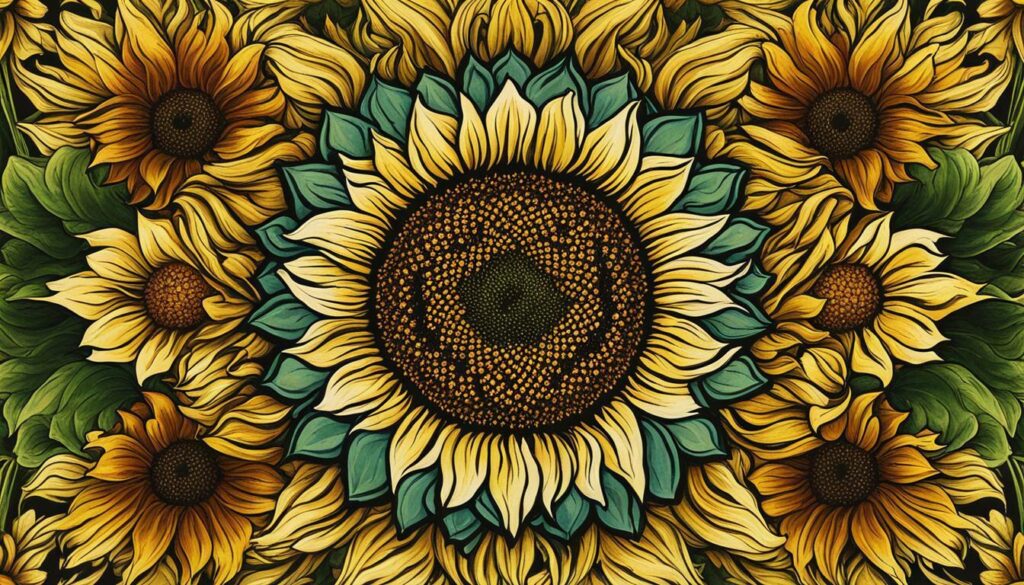The tournesol, or sunflower, has a rich symbolic meaning and history that spans across cultures and time. Known as “tournesol” in French, this vibrant flower holds significant cultural importance and is deeply rooted in various aspects of human life.
In the language of flowers, the tournesol represents admiration, loyalty, and love. Its majestic presence and vibrant yellow petals evoke feelings of admiration and adoration. It is a symbol of loyalty, representing steadfastness and unwavering commitment. And its association with love is a testament to its ability to brighten hearts and bring joy to those who gaze upon it.
One of the most fascinating aspects of the tournesol is its devotion and optimism. Throughout the day, it follows the path of the sun, facing it directly and symbolizing unwavering devotion and hope. This behavior has made the tournesol a symbol of optimism and a reminder to always seek the light, even in the darkest of moments.
The tournesol’s significance can also be traced back to ancient times. In Greek mythology, it is associated with the story of Clytie, who transformed into a sunflower after her lover, Apollo, turned her into a Heliotrope. The sunflower became a symbol of unrequited love, forever facing the sun in a longing gaze.
Similarly, the Aztecs revered the tournesol, seeing it as a symbol of worship and adoration. They believed that the sunflower represented the sun god and would place its golden petals in temples as offerings.
The golden color of the tournesol is associated with happiness and joy. Its vibrant hue evokes feelings of warmth and positivity, making it a delightful sight to behold. In many cultures, the tournesol is given as a gift to express admiration, support, and happiness.
Beyond its symbolic significance, the tournesol has numerous practical uses. It is widely cultivated for its oil, which is not only used in cooking but also in various industrial applications, including biofuel production. It is a versatile and valuable crop, providing both sustenance and economic benefits.
The tournesol’s beauty and symbolism have also made their way into the world of tattoo art. Sunflower tattoos are popular choices, symbolizing happiness, strength, and love. Their vibrant colors and intricate details make for stunning and meaningful body art.
In conclusion, the tournesol, or sunflower, holds a deep cultural significance and a rich symbolic meaning. From its associations with admiration, loyalty, and love in the language of flowers to its historical importance in various cultures and its practical uses in everyday life, the tournesol is a remarkable flower that continues to captivate and inspire.
Symbolism in the Language of Flowers
Within the language of flowers, the sunflower is widely recognized as a symbol of admiration, loyalty, and love. Its vibrant and cheerful appearance is often associated with positive emotions and heartfelt sentiments. The sunflower’s strong stalk and beautiful golden petals make it a captivating symbol of admiration, representing the admiration and respect one has for another.
Loyalty is another significant trait attributed to the sunflower. Just as the sunflower follows the sun’s path throughout the day, it symbolizes a steadfast and unwavering loyalty. This quality has made the sunflower a popular choice to convey loyalty and fidelity in various relationships.
Love is perhaps the most profound symbolism associated with the sunflower. Its bright and warm hues evoke feelings of affection and deep emotions. The sunflower’s open face, resembling the sun itself, is seen as a representation of love’s radiant and nurturing qualities. It is often given as a token of love and devotion to someone special.

In summary, the sunflower’s symbolism in the language of flowers is deeply rooted in its representation of admiration, loyalty, and love. Its beauty and significance have made it a cherished symbol in various cultures and occasions.
The Sunflower’s Devotion and Optimism
The sunflower’s unique characteristic of tracking the sun’s movement has made it a powerful symbol of devotion and optimism. As the sun rises in the morning, the sunflower faces east, following its path across the sky throughout the day. This behavior, known as heliotropism, represents the sunflower’s unwavering commitment to seeking the light and its ability to adapt to changing circumstances.
In cultures around the world, this quality of the sunflower has been associated with devotion and a positive outlook on life. Just as the sunflower turns its face towards the sun, individuals are inspired to remain steadfast in their dedication to their goals and remain optimistic, even in the face of challenges.
The symbolism of the sunflower’s devotion and optimism is beautifully captured in the words of Helen Keller, who famously said, “Keep your face to the sunshine and you cannot see the shadows.” This wisdom resonates with the sunflower’s ability to find strength and inspiration in the light, reminding us to always focus on the positive aspects of life.
| Symbolism | Meaning |
|---|---|
| Devotion | The sunflower’s ability to follow the sun reflects unwavering commitment and loyalty. |
| Optimism | By always seeking the light, the sunflower symbolizes a positive and hopeful mindset. |
As we contemplate the significance of the sunflower’s devotion and optimism, let us remember the power of staying true to our passions and maintaining a positive outlook, just like the tournesol. By embracing the sunflower’s symbolism, we can find inspiration in its unwavering dedication and strive to cultivate our own sense of devotion and optimism in our lives.

In conclusion, the sunflower’s ability to track the sun’s movement and its resulting symbolism of devotion and optimism have made it a cherished and influential flower throughout history. From ancient civilizations to modern-day traditions, the tournesol’s significance reminds us of the power of staying committed and maintaining a positive outlook in our lives.
Historical and Cultural Significance
The sunflower’s symbolism extends beyond its association with the language of flowers, as it holds historical and cultural significance in various civilizations, including Greek mythology and Aztec culture. In Greek mythology, the sunflower is believed to represent the nymph Clytie, who fell in love with the sun god Apollo. As the story goes, Clytie was transformed into a sunflower, forever gazing at the sun as it moved across the sky.
In Aztec culture, the sunflower, or “xochitl,” was highly revered. It was considered a symbol of fertility and was associated with the sun god Huitzilopochtli. The Aztecs believed that the sunflower represented strength, abundance, and the power to bring forth new life. They used sunflowers in various religious ceremonies and festivals, and the seeds were an important food source.
Table: Sunflower Symbolism in Greek Mythology and Aztec Culture
| Greek Mythology | Aztec Culture |
|---|---|
| Associated with the nymph Clytie | Symbol of the sun god Huitzilopochtli |
| Represents endless devotion to the sun god Apollo | Symbolizes strength, abundance, and fertility |
| Transformation from human to sunflower | Used in religious ceremonies and festivals |
The tournesol’s historical and cultural significance has made it a beloved symbol in various cultures around the world. Its association with devotion, fertility, and strength has made it an enduring emblem of positivity and hope. From the ancient Greeks to the Aztecs, the tournesol’s vibrant presence has left an indelible mark on human history and continues to inspire and fascinate people to this day.

The sunflower’s golden color is deeply connected to happiness, making it a versatile symbol of joy and positive sentiments. The vibrant hue of the tournesol evokes feelings of warmth and positivity, brightening any space it occupies. Its radiant petals are reminiscent of the sun, representing the light and energy that brings happiness into our lives.
Throughout history, cultures around the world have recognized and appreciated the sunflower’s association with happiness. Whether it is displayed in artwork, used as a gift, or cultivated for its beauty, the tournesol serves as a constant reminder of the positive aspects of life.
The sunflower’s golden color has also inspired artists, writers, and poets to capture its essence in their works. It has been the subject of countless paintings, symbolizing the pursuit of happiness and the celebration of life. Its vibrant yellow petals have become synonymous with joy and optimism, resonating with people of all ages and backgrounds.
 In addition to its symbolic significance, the sunflower’s golden color is a visual delight that captivates the eye. Whether it is a vast field of sunflowers stretching as far as the eye can see or a single bloom standing tall in a garden, the tournesol never fails to evoke a sense of happiness and wonder. Its radiant beauty reminds us to embrace the golden moments in life and to find joy in the simplest of things.
In addition to its symbolic significance, the sunflower’s golden color is a visual delight that captivates the eye. Whether it is a vast field of sunflowers stretching as far as the eye can see or a single bloom standing tall in a garden, the tournesol never fails to evoke a sense of happiness and wonder. Its radiant beauty reminds us to embrace the golden moments in life and to find joy in the simplest of things.
| Symbolism | Representation |
|---|---|
| Admiration | The tournesol represents admiration, making it a perfect gift to show appreciation for someone. |
| Loyalty | Just as the sunflower follows the sun, it symbolizes loyalty and steadfastness. |
| Love | The sunflower’s bright petals also represent love, making it a romantic symbol. |
Summary:
The sunflower’s golden color is deeply connected to happiness, symbolizing joy and positive sentiments. Its radiant petals evoke warmth and positivity, bringing a sense of light and energy into our lives. The tournesol has been used throughout history as a symbol of happiness in various forms, from artwork to gifts, and it continues to inspire artists and creators today. Its beauty and vibrant hue serve as a constant reminder to embrace the golden moments in life and find joy in the simplest things.
Sunflowers as Gifts of Admiration and Support
The act of offering sunflowers as gifts carries a powerful message of admiration, happiness, and support. In the language of flowers, sunflowers symbolize admiration and are a beautiful way to express your appreciation for someone’s qualities and achievements. Whether it’s for a loved one, a friend, or a colleague, presenting them with a bouquet of sunflowers is a meaningful gesture that conveys your admiration.
Sunflowers also have the ability to brighten someone’s day and bring happiness. Their vibrant yellow petals and striking appearance can instantly uplift spirits and bring a smile to anyone’s face. By gifting sunflowers, you are not only showing your support but also spreading joy and positivity.

In addition to admiration and happiness, sunflowers are a symbol of support. The strong and sturdy stems of sunflowers represent resilience and strength. By offering someone sunflowers, you are letting them know that you are there for them, supporting them through difficult times, and encouraging them to stay positive and optimistic.
Whether it’s to celebrate an accomplishment, show your appreciation, or simply bring a smile to someone’s face, giving sunflowers as gifts is a beautiful gesture that holds deep symbolism. Just like the sunflower itself, your gift will radiate warmth, admiration, and support to the person receiving it.
| Symbolism | Meaning |
|---|---|
| Admiration | Expressing appreciation for someone’s qualities and achievements. |
| Happiness | Bringing joy and positivity, brightening someone’s day. |
| Support | Showing resilience, strength, and being there for someone. |
Sunflowers Beyond Symbolism: Practical Uses
Beyond its symbolic meaning, the sunflower has practical uses as well, including being cultivated for oil production, serving as a source of food, and offering potential as a biofuel. The tournesol’s seeds are rich in oil, making it an important crop for sunflower oil production. This versatile oil is commonly used in cooking and cosmetics due to its light flavor and various health benefits. It is also a popular ingredient in salad dressings and mayonnaise.
The sunflower’s seeds, often referred to as kernels, are widely consumed as a nutritious snack and are a favorite ingredient in baking and cooking. These seeds are packed with essential nutrients like vitamin E, magnesium, and selenium, making them a healthy addition to any diet. Whether roasted, salted, or used in granola bars and trail mixes, sunflower seeds offer a delightful crunch and a burst of flavor.
Furthermore, the sunflower holds promise as a valuable biofuel resource. The plant’s high oil content and ease of cultivation make it an attractive candidate for biofuel production. Sunflower oil can be processed into biodiesel, which is a renewable, environmentally friendly alternative to fossil fuels. As the world seeks sustainable energy solutions, sunflowers may play a vital role in reducing our reliance on non-renewable resources.
| Practical Uses of Sunflowers | Benefits |
|---|---|
| Oil Production | Light-flavored sunflower oil with health benefits |
| Food Source | Nutritious and versatile sunflower seeds for snacks and cooking |
| Biofuel Potential | Sustainable source of biodiesel, reducing reliance on fossil fuels |
The sunflower’s practical uses go hand in hand with its symbolic significance. By cultivating this remarkable flower for oil, food, and biofuel production, we not only benefit from its diverse applications, but also honor its rich cultural heritage and enduring symbolism.

Sunflowers hold a special place in tattoo art, often symbolizing happiness, strength, and love in intricate designs. These bold and vibrant flowers are chosen by individuals seeking to express their positive outlook on life, their inner strength, and their deep emotional connections.
The sunflower’s bright yellow petals and distinctive shape make it a visually striking choice for tattoos. It is often depicted in large, detailed designs that showcase its beauty and radiance. Whether portrayed alone or alongside other elements such as birds or butterflies, sunflowers bring a sense of joy and optimism to any tattoo.
Some people choose sunflower tattoos as a reminder to always face the sun and stay focused on the positive aspects of life. The sunflower’s ability to turn its face towards the sun resonates with those who strive for personal growth and perseverance. It serves as a constant reminder to embrace happiness, overcome challenges, and stay true to oneself.

| Meaning of Sunflower Tattoos | Symbolism |
|---|---|
| Happiness | The sunflower’s bright and cheery appearance is often associated with happiness and positive emotions. |
| Strength | The sunflower’s tall and sturdy stem represents strength, resilience, and the ability to withstand adversity. |
| Love | As a symbol of loyalty, the sunflower can also represent deep love and unwavering commitment. |
Whether chosen for its symbolic meaning or simply for its aesthetic appeal, a sunflower tattoo is a beautiful and meaningful choice. It serves as a constant reminder to embrace happiness, find strength in challenging times, and cultivate love in all aspects of life.
Conclusion
The tournesol, with its rich symbolic significance and cultural importance, remains an enduring symbol of beauty, admiration, and happiness. As explored throughout this article, the sunflower holds a deep meaning in various aspects of life, from the language of flowers to ancient mythologies and modern-day expressions of love and support.
In the language of flowers, the tournesol represents admiration, loyalty, and love. Its vibrant yellow petals and ability to follow the sun throughout the day have made it a symbol of devotion and optimism. Across different cultures, the tournesol has been revered and mentioned in ancient stories, such as Greek mythology and the Aztecs’ admiration for its magnificence.
The golden color of the sunflower is associated with happiness and joy. It is often given as a gift to express admiration, support, and to brighten someone’s day. Whether as a bouquet or a single stem, the tournesol carries with it a message of positivity and heartfelt emotions.
Beyond its symbolic significance, the tournesol also has practical uses. Its cultivation for oil production, its role as a food source, and its potential as a biofuel showcase the versatility and value of this remarkable flower. Additionally, in the world of tattoo art, the tournesol is a popular choice, representing happiness, strength, and love.
In conclusion, the tournesol, or sunflower, is a testament to the enduring power of symbolism. With its rich history and cultural significance, it continues to captivate and inspire. Whether as a gift, a tattoo, or a representation of joy and optimism, the tournesol remains an emblematic flower that holds a special place in our hearts and culture.
FAQ
What does the tournesol, or sunflower, symbolize in the language of flowers?
The tournesol represents admiration, loyalty, and love.
Why is the sunflower associated with devotion and optimism?
The sunflower’s ability to follow the sun throughout the day has made it a symbol of devotion and optimism.
What is the historical and cultural significance of the tournesol?
The sunflower has been mentioned in Greek mythology and was revered by the Aztecs, highlighting its enduring importance throughout history.
Why is the golden color of the sunflower associated with happiness?
The vibrant golden color of the sunflower is closely connected to feelings of joy and happiness.
What emotions and sentiments can be conveyed by giving tournesols as gifts?
Offering tournesols can express admiration, happiness, and support, brightening someone’s day or conveying heartfelt emotions.
What are the practical uses of sunflowers beyond their symbolism?
Sunflowers are widely cultivated for their oil and have many practical uses, including as a food source and biofuel.
What do sunflower tattoos symbolize in tattoo art?
Sunflower tattoos can symbolize happiness, strength, and love, and are popular among tattoo enthusiasts.
- Comment s’occuper de tulipe? - October 22, 2023
- Tulipe qui se ferme la nuit? - October 22, 2023
- Ou acheter tulipe? - October 22, 2023







